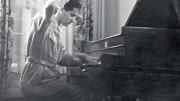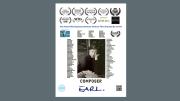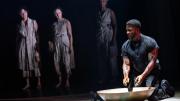Nearly a quarter-century has passed since the death of Leonard Bernstein ’39, D.Mus. ’67, yet his prodigious talent and flair for attracting an audience continue to work their charms. Call it the afterlife of the media age. Bernstein’s epic performances of symphonies by Gustav Mahler and his charismatic appearances on national television, especially in the widely praised Young People’s Concerts with the New York Philharmonic, are reissued periodically in ever-new formats. And his major works for the stage, including West Side Story, Candide, and Mass, are revived at regular intervals. A Bernstein industry is in place, with The Leonard Bernstein Office in New York City managing his intellectual property and the Library of Congress regularly acquiring new materials for its voluminous collection of his papers. Added to that, the New York Philharmonic Leon Levy Digital Archive has uploaded hundreds of Bernstein’s personally annotated conducting scores into an open-access repository, making it possible to study his interpretative decisions. Fresh assessments of Bernstein’s work as composer, conductor, and pianist appear with growing frequency, and today’s emerging acceptance of homosexuality makes it possible to explore with candor the complex life of a man who had many gay relationships (yet managed to thrive in a closeted America) at the same time as he was devoted to his wife, Felicia Montealegre.
Nigel Simeone’s The Leonard Bernstein Letters adds to the growing list of titles about Bernstein, offering an annotated and substantive selection of correspondence. Some of these documents have been published previously, while others are newly printed. All told, the letters selected by Simeone, a writer and critic whose books include Leonard Bernstein: West Side Story, are strongest in documenting Bernstein’s personal relationships. This was no fly-by-night friend but a man of remarkable loyalty. The letters reveal less about his work as a composer, and as the volume proceeds into the 1950s, a dizzyingly packed performance schedule and easy access to the telephone take a toll: the letters grow short, with major gaps in time, and they yield a less coherent story. As a result, the first half of the book provides the most gratifying experience for the reader. Yet there are gems from the later years as well, especially in Bernstein’s long and loving correspondence with his wife.
Bernstein’s undergraduate experience at Harvard is chronicled vividly. Writing in 1937 to Sid Ramin, a childhood friend from Roxbury who later became the orchestrator of West Side Story, he described how to reach his room in Eliot House from the Harvard Square T stop. Walk down Dunster Street “as far as you can,” Bernstein directed Ramin. “Go to G (gee) entry, walk up to Room 41 (all doors are marked) and knock vigorously. Voilà.” Even at this early date, a solid network of personal relationships was in place, whether with childhood friends like Ramin, Beatrice Gordon, or Mildred Spiegel; the piano teacher Helen Coates (who later became Bernstein’s lifelong personal assistant); or a growing number of professional musicians, including the conductor Dimitri Mitropoulos and the composer Aaron Copland.
Bernstein struggled with Harvard’s music department, which was then quite conservative. “[Tillman] Merritt hates me, but Mother loves me. [Walter] Piston doubts me, but Copland encourages me,” he lamented in 1938 to Kenneth Ehrman, a friend from Eliot House. “I hate the Harvard Music Department. You can quote that…. I hate it because it is stupid & highschoolish and ‘disciplinary’ and prim and foolish and academic and stolid and fussy.” Yet Bernstein already had a knack for seizing the limelight, which trumped his frustrations. “I’ve graduated with a bang,” he reported in another letter to Ehrman. “An incredible A in the Government course, and a cum laude. A great class day skit which I performed to a roaring crowd through a mike, and got in some parting cracks…at the old school and its officials.”
By his early twenties, Bernstein was still a kid in many ways, yet on the verge of becoming a household name. “I bruised my metacarpal (!) playing baseball this afternoon. All of which makes good for concerto-playing the 25th!” he wrote in 1941 to Shirley Gabis, a close friend from Philadelphia, as he graduated from the Curtis Institute of Music with a master’s degree in conducting. Two years later, Bernstein was appointed assistant conductor of the New York Philharmonic and wrote a beguiling account of his ineffectual negotiations with Arthur Judson, the Philharmonic’s powerful manager, in a letter to his mentor Serge Koussevitzky, conductor of the Boston Symphony Orchestra. “Believe me, I tried very hard to feel like Koussevitzky while I was in the Judson office,” the young musician declared, “but I was only Leonard Bernstein, and I had to act as I did.” That same fall, he described his modest apartment in the Carnegie Hall studios, which at that point had no furniture. “My shirts are all in suitcases,” he reported to his friend Renée Longy Miquelle, director of the Longy School of Music in Cambridge, which had been founded by her father. Within a few months of signing a contract with the Philharmonic—while still living out of a suitcase—Bernstein famously substituted for Bruno Walter and made such a splash that he inspired a rave review on the front page of the The New York Times.
Correspondence with Aaron Copland threads through the book, starting with Bernstein’s Harvard years. An intense romantic liaison existed alongside a rewarding professional partnership. “What terrifying letters you write,” declared Copland in 1940, “fit for the flames is what they are.” Those letters also chronicle the degree to which Bernstein served as a central advocate for Copland’s music, conducting it around the world and eventually programming it frequently with the Philharmonic. In 1947, as part of an important series of postwar concerts that helped reopen transatlantic musical networks, Bernstein conducted the European premiere of Copland’s Third Symphony in Prague with the Czech Philharmonic Orchestra. “First I must say it’s a wonderful work,” he reported to Copland. “Coming to know it so much better I find in it new lights and shades—and new faults,” launching an audacious critique. “Sweetie, the end is a sin. You’ve got to change….We must talk – about the whole last movement, in fact.” As time passed, the emotional intensity of Bernstein’s correspondence with Copland dimmed, even as the fundamental tie remained strong. Yet there were ambivalences on both sides. When Felicia Bernstein died of cancer in 1978—a loss from which Bernstein never fully recovered—Copland sent a jarringly brief note before her memorial. “I’m not going to be present at the ‘Remembrance’ for Felicia on the 18th,” Copland declared, “because I am under contract to conduct the same day in Virginia (Norfolk).”
Taken as a whole, Bernstein’s correspondence brings the reader up close to his growing celebrity, which increased apace after World War II, as access to air travel made it possible to be a jet-set conductor and the advent of LP recordings opened up a mass market for symphonic works. In the process, Bernstein became the Elvis Presley of classical music.
Time and again, the letters show the intoxication of celebrity. “They say there hasn’t been such a scene in a Budapest concert hall since Toscanini was here,” Bernstein reported to Helen Coates from a European tour in 1948. “The audience stamped & shouted…. The bobby-soxers tonight beat everything I’ve ever seen. I’m exhausted.” A month later, writing from the Netherlands to his friend David Oppenheim: “I live like a king, I have screaming audiences and flowers at my concerts, and even a lover.” At the end of this tour, Bernstein summed up his triumph to yet another friend: “I am swollen with success, lush with living, loving and learning. Germany and Austria were fabulous, filthy, Nazi, exciting. Budapest was grim and gay. Milano was the greatest. Paris a joy, as ever, and Holland a comfort.”
Bernstein’s allegiance to his Jewish heritage resonates throughout the letters. Writing in 1946, he expressed gratitude to Solomon Braslavsky, the organist, choir director, and composer at his family synagogue in Roxbury: “I have come to realize what a debt I really owe to you—personally—for the marvelous music at Mishkan Tefila services.” Their bond remained strong, and a decade later, Braslavsky congratulated Bernstein when he was named principal conductor of the New York Philharmonic, becoming the first American to hold the post. “My prophecy became a reality,” Braslavsky wrote his protégé, congratulating Bernstein for having resisted pressure to de-Semitize his identity. “You reached your goal by your own merits…and with your own name. It is neither bernini, nor steinkovsky. It is what you always were, what you are, and what you always will be.”
Even in Bernstein’s later years, when the correspondence becomes uneven, notable exchanges turn up. In 1968, for example, Jackie Kennedy wrote a loving thank-you after Bernstein conducted the Adagietto from Mahler’s Fifth Symphony at the funeral of her brother-in-law Robert Kennedy. “Will you tell your noble orchestra, drowning in heat and cables when I passed them,” she implored, “…how beautiful you were—how many people cried—people who don’t know music.” A striking letter arrived in 1988 from jazz trumpeter Miles Davis, who congratulated Bernstein on his seventieth birthday. Twenty years earlier, Davis recalled, he had balked at performing music from West Side Story, declaring it to be “corny shit.” But his attitude had evolved over time. In the letter, he acknowledged to Bernstein that the show had “turned out to be a classic,” and he placed Bernstein in a pantheon alongside great African-American musicians: “You are one of America’s true geniuses along with Monk, Gillespie, Mingus and Parker.
Time and again, The Leonard Bernstein Letters demonstrate how the composer and conductor lived in overdrive. With an outsized musical talent—and an equally extravagant gift in front of a camera—he appeared at a historical moment when a maestro could be both Jewish and American-born. There were no precedents for that particular combination. Yet Bernstein attained artistic authority in an era when the classical-music industry was at its peak, and his life and work continue to captivate music lovers the world over.









